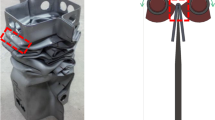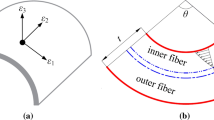Abstract
Background
The VDA 238–100 tight radius V-bend test can be used to efficiently characterize the bendability and fracture limits of sheet metals in severe plane strain bending. Material performance in plane strain bending is critical for the selection of advanced high strength steels for energy absorbing structural components.
Objective
The detection of failure based upon a reduction in the punch force can lead to erroneous predictions of failure for ductile or thin gage alloys in the VDA 238–100 test. New failure criteria were proposed and evaluated across a range of automotive steels.
Methods
Four detection methods in the V-bend test were evaluated based upon the load drop, bending moment, novel stress metric and the strain rate for seven steels with strength levels from 270 to 1500 MPa. The appropriate failure threshold was identified from visual inspection of the surface during bending.
Results
The vertical punch force will decrease as a consequence of the mechanics in the V-bend test at intermediate bend angles even without fracture. The novel stress-based metric accounts for sheet thinning and could successfully identify “false positives” and punch lift-off when considering the strain-rate evolution.
Conclusions
Failure detection using the VDA load threshold method may significantly under-report the bend performance of alloys with intermediate-to-high bendability or thin gauges. The proposed stress-based metric can reliably detect fracture for bend angles in excess of 160° and be readily calculated using the existing data. The VDA load threshold for failure can work well for materials that exhibit significant cracking.




























Similar content being viewed by others
References
Abedrabbo N, Mayer R, Thompson A, Salisbury C, Worswick M, van Riemsdijk I (2009) Crash response of advanced high-strength steel tubes: experiment and model. Int J Impact Eng 36:1044–1057
Abramowicz W, Jones N (1986) Dynamic progressive buckling of circular and square tubes. Int J Impact Eng 4(4):243–270
Abramowicz W, Jones N (1997) Transition from initial global bending to progressive buckling of tubes loaded statically and dynamically. Int J Impact Eng 19(5–6):415–437
Boul I, Lang M, Mees G, Sponem F, Sturel T, Garat X (2007) Bending test and bendability of ultra high strenght steels, IDDRG 2007, Hungary
Cheong K, Butcher C, Dykeman, J (2018) The influence of the through-thickness strain gradients on the fracture characterization of advanced high-strength steels. SAE International Journal of Materials and Manufacturing 11(4):541–552
Cheong K, Omer K, Butcher C, George R, Dykeman J (2017) Evaluation of the VDA 238–100 Tight Radius Bending Test Using Digital Image Correlation Strain Measurements. Journal of Physics: Conference Series, 896
Dunand M, Mohr D (2010) Hybrid experimental-numerical analysis of basic ductile fracture experiments for sheet metals. Int J Solids Struct 47:1130–1143
Grolleau V, Roth CC, Lafile V, Galpin B, Mohr D (2019) Loading of mini-Nakazima specimens with a dihedral punch: Determinating the strain to fracture for plane strain tension through stretch-bending. Int J Mech Sci 152:329–345
Hill R (1950) Mathematical theory of plasticity. Oxford University Press
Hotz W, Merklein M, Kuppert A, Friebe H, Klein M (2013) Time dependent FLC determination – comparison of different algorithms to detect the onset of unstable necking before fracture. Key Engineering Mateerials Sheet Metal 2013(549):397–404
ISO 12004-2 (2008) Metallic materials – sheet and strip - determination of forming-limit curves – Part 2: Determination of Forming-Limit Curves in the Laboratory
ten Kortenaar L. (2016) Failure characterization of hot formed boron steels with tailored mechanical properties, MASc thesis, University of Waterloo
Labudde T, Bleck, W, (2011). Characterization of ductility of ultra-high strength steels, Steel research international: special edition, 1090–1095
Larour P, Hackl B, Leomann F, Benedyk K (2012). Bending angle calculation in the instrumented three-point bending test, IDDRG 2012, India
Larour P, Hackl B, Leomann F (2013) Sensitivity analysis on the calculated bending angle in the instrumented bending test. IDDRG 2013, Zurich
Mohr D, Henn S (2007) Calibration of stress-triaxiality dependent crack formation criteria: A new hybrid experimental-numerical method. Exp Mech 47:805–820
Noder J, Butcher C (2019). A comparative investigation into the influence of the constitutive model on the prediction on in-plane formability for Nakazima and Marciniak tests. Int J Mech Sci. https://doi.org/10.1016/j.ijmecsci.2019.105138
Noder J, Abedini A, Butcher C (2020) Evaluation of the VDA 238–100 tight radius bend test for plane strain fracture characterization of automotive sheet metals. Exp Mech 60:787–800
Pack K, Ahn K, Huh H, Lou Y (2014) Fracture modelling of DP780 sheets using a hybrid experimental-numerical method and two-dimensional digital image correlation. Int J Mater Prod Tec 48(1):34–46
Roth CC, Mohr D (2016) Ductile fracture experiments with locally proportional loading histories. Int J Plast 79:328–354
Stoughton TB, Yoon JW (2011) A new approach for failure criterion for sheet metals. Int J Plast 27(3):440–459
Troive L (2017) New method for evaluation of bendability based on three-point-bending and the evolution of the cross-section moment. J Phys Conf Ser 896(1):012006. https://doi.org/10.1088/1742-6596/896/1/012006
VDA 238–100, (2010). Test specification: plate bending test for metallic materials
VDA 238–100, (2017). Test specification: plate bending test for metallic materials
Volk W, Hora P (2011) New algorithm for a robust user-independent evaluation of beginning instability for the experimental FLC determination. Int J Mater Form 4:339–346
Wagner, L, Schauer, H, Pauli, H, Hinterdorfer, J (2019) Improved bendability characterization of UHSS sheets. IOP Conference Series: Materials Science and Engineering, vol 651, 38th International Deep Drawing Research Group Annual Conference (IDDRG 2019) 3–7 June 2019, Enschede
Yu TX, Zhang LC (1996) Plastic bending: theory and applications. Series on Engineering Mechanics 2:572
Author information
Authors and Affiliations
Corresponding author
Ethics declarations
Funding and Acknowledgements
Financial support for this study was provided in part by the Natural Sciences and Engineering Research Council of Canada, the American Iron and Steel Institute (AISI), and Honda Research Americas (HRA). The authors would particularly like to thank Dr. Hesham Ezzat of AISI and Dr. Kishore Pydimarry of HRA for their support of the project. We would also like to gratefully acknowledge Kenneth Cheong from the University of Waterloo for his valuable discussion on V-bend experiments and Pedram Samadian for quenching of the PHS1500 sheets. The authors would like to thank Amir Zhumagulov for characterizing the 270 Mild steel constitutive response. The excellent work by Dr. Larour from voestalpine Stahl GmbH was particularly valuable for thinning evaluation in the tight-radius bend test.
Conflict of Interest
The authors declare that they have no conflict of interest.
Additional information
Publisher’s Note
Springer Nature remains neutral with regard to jurisdictional claims in published maps and institutional affiliations.
Appendix A
Appendix A
Rights and permissions
About this article
Cite this article
Noder, J., Dykeman, J. & Butcher, C. New Methodologies for Fracture Detection of Automotive Steels in Tight Radius Bending: Application to the VDA 238–100 V-Bend Test. Exp Mech 61, 367–394 (2021). https://doi.org/10.1007/s11340-020-00627-z
Received:
Accepted:
Published:
Issue Date:
DOI: https://doi.org/10.1007/s11340-020-00627-z




